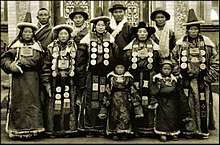Yugur
The Yugurs, Yughurs, Yugu (Chinese: 裕固族; pinyin: Yùgù Zú) or Yellow Uyghurs,[1] as they are traditionally known, are a Turkic and Mongolic group and one of China's 56 officially recognized ethnic groups, consisting of 13,719 persons according to the 2000 census.[2] The Yugur live primarily in Sunan Yugur Autonomous County in Gansu, China. They are Tibetan Buddhists.[3][4]
 | |
| Total population | |
|---|---|
| 15,000 (est.) | |
| Regions with significant populations | |
| Sunan Yugur Autonomous County, Gansu, China | |
| Languages | |
| Western Yugur, Eastern Yugur | |
| Religion | |
| Tibetan Buddhism, Tengrism (Turkic Shamanism) | |
| Related ethnic groups | |
| Old Uyghurs, other Turkic peoples and Mongols |
Name
The ethnic groups' current, official name, Yugur, derived from its autonym: the Turkic-speaking Yugur designate themselves as Yogïr, "Yugur" or Sarïg Yogïr, "Yellow Yugur" and the Mongolic-speaking Yugur likewise use either Yogor or Šera Yogor, "Yellow Yugur". Chinese historical documents have recorded these ethnonyms as Sālǐ Wèiwùr or Xīlǎgǔr. During the Qing dynasty, the Yugur were also called by a term that included "fān", the Classical Chinese term for Tibetic ethnic groups (Chinese: 西喇古兒黃番; pinyin: Xīlǎgǔr Huáng Fān, "Xīlǎgǔr Yellow Barbarians/Tibetans"). In order to distinguish both groups and their languages, Chinese linguists coined the terms Xībù Yùgùr, "Western Yugur" and Dōngbù Yùgùr, "Eastern Yugur" based on their geographical distribution.
History
The Turkic-speaking Yugurs are considered to be the descendants of a group of Uyghurs who fled from Mongolia southwards to Gansu after the collapse of the Uyghur Khaganate in 840, where they established the prosperous Ganzhou Uyghur Kingdom (870-1036) with capital near present Zhangye at the base of the Qilian Mountains in the valley of the Ruo Shui.[5] The population of this kingdom, estimated at 300,000 in Song chronicles, practised Manichaeism and Buddhism in numerous temples throughout the country.
In 1037 the Yugur came under Tangut domination.[6] The Gansu Uyghur Kingdom was forcibly incorporated into the Western Xia after a bloody war that raged from 1028–1036.
The Mongolic-speaking Yugurs are probably the descendants of one of the Mongolic-speaking groups that invaded North China during the Mongol conquests of the thirteenth century. The Yugurs were eventually incorporated into Qing China in 1696 during the reign of the second Qing ruler, the Kangxi Emperor (1662–1723).
In 1893, Russian explorer Grigory Potanin, the first Western scientist to study the Yugur, published a small glossary of Yugur words, along with notes on their administration and geographical situation.[7] Then, in 1907, Carl Gustaf Emil Mannerheim visited the Western Yugur village of Lianhua (Mazhuangzi) and the Kangle Temple of the Eastern Yugur. Mannerheim was the first to conduct a detailed ethnographic investigation of the Yugur. In 1911, he published his findings in an article for the Finno-Ugrian Society.
Language
About 4,600 of the Yugurs speak Western Yugur (a Turkic language) and about 2,800 Eastern Yugur (a Mongolic language). Western Yugur has preserved many archaisms of Old Uyghur.[8][9] The remaining Yugurs of the Autonomous County lost their respective Yugur language and speak Chinese. A very small number of the Yugur reportedly speak Tibetan. They use Chinese for intercommunication.
Both Yugur languages are now unwritten, although the Old Uyghur alphabet was in use in some Yugur communities until end of 19th century.[10]
People
The Turkic-speaking Yugur mainly live in the western part of the County in Mínghuā District, in the Townships of Liánhuā and Mínghǎi, and in Dàhé District, in the centre of the County. The Mongolic-speaking Yugur mainly live in the County's eastern part, in Huángchéng District, and in Dàhé and Kānglè Districts, in the centre of the County.
The Yugur people are predominantly employed in animal husbandry.
Religion
| Part of a series on |
| Vajrayana Buddhism |
|---|
 |
|
Traditions Historical traditions:
New branches:
|
|
History |
|
Pursuit |
|
Practices
Fourfold division:
Twofold division: Thought forms and visualisation: Yoga:
|
|
Festivals |
|
Tantric texts |
|
Ordination and transmission |
The traditional religion of the Yugur is Tibetan Buddhism, which used to be practised alongside shamanism.
References
- Justin Jon Rudelson; Justin Ben-Adam Rudelson (1997). Oasis Identities: Uyghur Nationalism Along China's Silk Road. Columbia University Press. pp. 206–. ISBN 978-0-231-10786-0.
- Justin Keith Brown, Sarah Ogilvie (2009). Concise encyclopedia of languages of the world. Elsevier. p. 1142. ISBN 978-0-08-087774-7. Retrieved 2010-10-31.
- Justin Ben-Adam Rudelson, Justin Jon Rudelson (1997). Oasis identities: Uyghur nationalism along China's Silk Road. Columbia University Press. p. 178. ISBN 0-231-10786-2. Retrieved 2010-10-31.
- Wong, Edward (September 28, 2016). "Modern Life Presents Nomads of China's Steppe With a 'Tragic Choice'". New York Times.
- Allworth, Edward A. (1994). Central Asia, 130 Years of Russian Dominance: A Historical Overview. Duke University Press. p. 89. ISBN 0-8223-1521-1.
- Dillon, Michael (2004). Xinjiang: China's Muslim Far Northwest. Taylor & Francis. p. 10. ISBN 978-0-203-16664-2.
- Tamm, Eric Enno (10 April 2011). The Horse That Leaps Through Clouds: A Tale of Espionage, the Silk Road and the Rise of Modern China. Catapult. p. 281. ISBN 978-1-58243-876-4.
- Aslı Göksel, Celia Kerslake, ed. (2000). Studies on Turkish and Turkic Languages: Proceedings of the Ninth International Conference on Turkish Linguistics. Harrassowitz. pp. 430–431. ISBN 978-3447042932.
- Lars Johanson, Éva Csató (1998). The Turkic languages. Taylor & Francis. p. 397. ISBN 0-415-08200-5. Retrieved 2010-10-31.
- Dru C. Gladney (2004). Dislocating China: reflections on Muslims, minorities and other subaltern subjects. C. Hurst & Co. Publishers. p. 212. ISBN 1-85065-324-0. Retrieved 2010-10-31.
External links
- Slide shows, maps and other material on the Yugur from author Eric Enno Tamm
- Original Western Yugur texts with English translation plus PDF grammar of Sarig Yugur